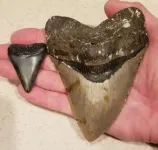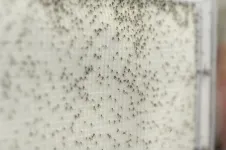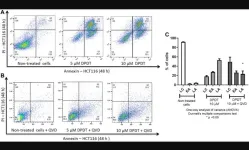(Press-News.org) The largest marine predator that ever lived was no cold-blooded killer.
Well, a killer, yes. But a new analysis by environmental scientists from UCLA, UC Merced and William Paterson University sheds light on the warm-blooded animal’s ability to regulate its body temperature — and might help explain why it went extinct.
After analyzing isotopes in the tooth enamel of the ancient shark, which went extinct about 3.6 million years ago, the scientists concluded the megalodon could maintain a body temperature that was about 13 degrees Fahrenheit (about 7 degrees Celsius) warmer than the surrounding water.
That temperature difference is greater than those that have been determined for other sharks that lived alongside the megalodon and is large enough to categorize megalodons as warm-blooded.
The paper, published in Proceedings of the National Academy of Sciences, suggests that the amount of energy the megalodon used to stay warm contributed to its extinction. And it has implications for understanding current and future environmental changes.
“Studying the driving factors behind the extinction of a highly successful predatory shark like megalodon can provide insight into the vulnerability of large marine predators in modern ocean ecosystems experiencing the effects of ongoing climate change,” said lead researcher Robert Eagle, a UCLA assistant professor of atmospheric and oceanic sciences and member of the UCLA Institute of the Environment and Sustainability.
Megalodons, which are believed to have reached lengths up to 50 feet, belonged to a group of sharks called mackerel sharks — members of that group today include the great white and thresher shark. While most fish are cold-blooded, with body temperatures that are the same as the surrounding water, mackerel sharks keep the temperature of all or parts of their bodies somewhat warmer than the water around them, qualities called mesothermy and regional endothermy, respectively.
Sharks store heat generated by their muscles, making them different from fully warm-blooded or endothermic animals like mammals. In mammals, a region of the brain called the hypothalamus regulates body temperature.
Various lines of evidence have hinted that megalodon might have been mesothermic. But without data from the soft tissues that drive body temperature in modern sharks, it has been difficult to determine if or to what extent megalodon was endothermic.
In the new study, the scientists looked for answers in the megalodon’s most abundant fossil remains: its teeth. A main component of teeth is a mineral called apatite, which contains atoms of carbon and oxygen. Like all atoms, carbon and oxygen can come in “light” or “heavy” forms known as isotopes, and the amount of light or heavy isotopes that make up apatite as it forms can depend on a range of environmental factors. So the isotopic composition of fossil teeth can reveal insights about where an animal lived and the types of foods it ate, and — for marine vertebrates — information like the chemistry of the seawater where the animal lived and the animal’s body temperature.
“You can think of the isotopes preserved in the minerals that make up teeth as a kind of thermometer, but one whose reading can be preserved for millions of years,” said Randy Flores, a UCLA doctoral student and fellow of the Center for Diverse Leadership in Science, who worked on the study. “Because teeth form in the tissue of an animal when it’s alive, we can measure the isotopic composition of fossil teeth in order to estimate the temperature at which they formed and that tells us the approximate body temperature of the animal in life.”
Because most ancient and modern sharks are unable to maintain body temperatures significantly higher than the temperature of surrounding seawater, the isotopes in their teeth reflect temperatures that deviate little from the temperature of the ocean. In warm-blooded animals, however, the isotopes in their teeth record the effect of body heat produced by the animal, which is why the teeth indicate temperatures that are warmer than the surrounding seawater.
The researchers hypothesized that any difference between the isotope values of the megalodon and those of other sharks that lived at the same time would indicate the degree to which the megalodon could warm its own body.
The researchers collected teeth from the megalodon and other shark contemporaries from five locations around the world, and analyzed them using mass spectrometers at UCLA and UC Merced. Using statistical modeling to estimate sea water temperatures at each site where teeth were collected, the scientists found that megalodons’ teeth consistently yielded average temperatures that indicated it had an impressive ability to regulate body temperature.
Its warmer body allowed megalodon to move faster, tolerate colder water and spread out around the world. But it was that evolutionary advantage that might have contributed to its downfall, the researchers wrote.
The megalodon lived during the Pliocene Epoch, which began 5.33 million years ago and ended 2.58 million years ago, and global cooling during that period caused sea level and ecological changes that the megalodon did not survive.
“Maintaining an energy level that would allow for megalodon’s elevated body temperature would require a voracious appetite that may not have been sustainable in a time of changing marine ecosystem balances when it may have even had to compete against newcomers such as the great white shark,” Flores said.
Project co-leader Aradhna Tripati, a UCLA professor of Earth, planetary and space sciences and a member of the Institute of Environment and Sustainability, said the scientists now plan to apply the same approach to studying other species.
“Having established endothermy in megalodon, the question arises of how frequently it is found in apex marine predators throughout geologic history,” she said.
END
Megalodon was no cold-blooded killer
A killer, yes. But analysis of tooth minerals reveals how the warm-blooded predator maintained its body temperature
2023-06-26
ELSE PRESS RELEASES FROM THIS DATE:
UCalgary study provides insight into how an infectious parasite uses immune cells as a Trojan Horse
2023-06-26
University of Calgary researchers have discovered how Leishmania parasites hide within the body to cause Leishmaniasis. The tiny parasites are carried by infected sand flies. Considered a tropical disease, one to two million people in more than 90 countries are infected every year. Effects range from disfiguring skin ulcers to enlarged spleen and liver and even death.
This chronic disease has been difficult to detect in the early stages. Scientists realized that the parasite was somehow manipulating immune cells but this process had not been well understood.
“This is the first study that shows how the parasite stalls the process of regular ...
Poop and prey help researchers estimate that gray whales off Oregon Coast consume millions of microparticles per day
2023-06-26
CORVALLIS, Ore. – Oregon State University researchers estimate that gray whales feeding off the Oregon Coast consume up to 21 million microparticles per day, a finding informed in part by poop from the whales.
Microparticle pollution includes microplastics and other human-sourced materials, including fibers from clothing. The finding, just published in the journal Frontiers in Marine Science, is important because these particles are increasing exponentially and predicted to continue doing so in the coming decades, according to researchers Leigh Torres and Susanne Brander.
Microparticle pollution is a threat to the health of ...
A smarter way to monitor critical care patients
2023-06-26
Surgical and intensive care patients face a higher risk of death and longer hospital stays because they are susceptible to both hypotension and hemodynamic instability – or unstable blood flow.
These potential complications require round-the-clock monitoring of several cardiac functions by nurses and physicians, but there’s currently no singular, convenient device on the market that can measure the most vital aspects of a patient’s cardiovascular health.
Ramakrishna Mukkamala, professor of bioengineering at the University of Pittsburgh Swanson School of Engineering, and Aman Mahajan, ...
DPDT anticancer activity in human colon cancer HCT116 cells
2023-06-26
“Altogether, our results show that DPDT preferentially targets HCT116 colon cancer cells likely through DNA topoisomerase I poisoning.”
BUFFALO, NY- June 26, 2023 – A new research paper was published in Oncotarget's Volume 14 on June 21, 2023, entitled, “Diphenyl ditelluride anticancer activity and DNA topoisomerase I poisoning in human colon cancer HCT116 cells.”
Diphenyl ditelluride (DPDT) is an organotellurium (OT) compound with pharmacological properties, including antioxidant, antigenotoxic and antimutagenic activities when applied at low concentrations. However, ...
Society of Nuclear Medicine and Molecular Imaging announces 2023 fellows
2023-06-26
Chicago, Illinois – The Society of Nuclear Medicine and Molecular Imaging recognized ten new SNMMI Fellows today during a plenary session at the society’s 2023 Annual Meeting, held June 24-27. The SNMMI Fellowship was established in 2016 to recognize distinguished service to the society as well as exceptional achievement in the field of nuclear medicine and molecular imaging. It is among the most prestigious formal recognitions available to long-time SNMMI members.
In keeping with tradition, SNMMI’s 2022-23 president, Munir Ghesani, MD, FACNM, FACR, Mount Sinai Hospital, New York, ...
Purdue-launched solid rocket motor-maker Adranos flies off with Anduril
2023-06-26
WEST LAFAYETTE, Ind. – Adranos Inc., a Purdue-originated company that grew from a doctoral project into an impactful company, has been acquired by a major Costa Mesa, California-based defense products company, Anduril Industries.
Terms of the deal were settled, and the acquisition was announced on Sunday (June 25) in The Wall Street Journal that Anduril Industries is to purchase Adranos, manufacturer of solid rocket motors and maker of ALITEC, a high-performance solid rocket fuel that gives greater payload capacity, range and speed to launch systems.
“The success of Adranos is the latest manifestation ...
Webb makes first detection of crucial carbon molecule
2023-06-26
A team of international scientists has used NASA’s James Webb Space Telescope to detect a new carbon compound in space for the first time. Known as methyl cation (pronounced cat-eye-on) (CH3+), the molecule is important because it aids the formation of more complex carbon-based molecules. Methyl cation was detected in a young star system, with a protoplanetary disk, known as d203-506, which is located about 1,350 light-years away in the Orion Nebula.
Carbon compounds form the foundations of all known life, ...
Despite environmental trade-offs, dairy milk is a critical, low-impact link in global nutrition
2023-06-26
Philadelphia, June 26, 2023 – Along with all global sectors, the dairy industry is working to reduce its environmental impact as we look toward a shared 2050 net zero future. Research is currently focused on greenhouse gas mitigation strategies that do not compromise animal health and production, but many discussions maintain that a radical transformation—involving reducing animal-based foods and increasing plant-based foods—is needed in our agriculture production systems in order ...
Would you detour with me? – Well, that depends on the dog breed!
2023-06-26
A new study from the Department of Ethology, Eötvös Loránd University, showed that dogs may not equally benefit from observing the ‘helpful action’ of a human demonstrator in the classic detour around a V-shaped fence task.
Those who are experienced with the world of ethological conferences, know all too well that if you present your work about dog behavior, the first (or second) question from the audience will be: “And did you check whether the breed of the dog had an effect on your results?”
Actually, this is not surprising as most people are familiar with the mindboggling variability of hundreds of ...
UCLA researchers uncover potential biomarkers of positive response to immunotherapy
2023-06-26
FINDINGS
Scientists at the UCLA Jonsson Comprehensive Cancer Center have identified potential new biomarkers that could indicate how someone diagnosed with metastatic melanoma will respond to immunotherapy treatment.
The researchers found when T cells are activated, they release a protein called CXCL13, which helps attract more B cells and T cells to the tumor site. The B cells then show the T cells specific parts of the tumor, which leads to increased activation of the T cells and their ability to fight the cancer. This cooperation between T cells and B cells was associated with improved survival in patients diagnosed with metastatic melanoma ...
LAST 30 PRESS RELEASES:
New modeling approach sheds light on rare gut disease
Study documents potentially hazardous flame retardants in firefighter gear
Can certain bacteria regulate aging of the immune system and its related alterations?
AI model helps diagnose often undetected heart disease from simple EKG
There are fewer online trolls than people think
Cell membrane fluctuations produce electricity
Jeonbuk National University study shows positive parenting can protect adolescents against self-harm
Surface-engineered ZnO nanocrystals to tackle perfluoroalkyl substance contamination
This new understanding of T cell receptors may improve cancer immunotherapies
A new fossil face sheds light on early migrations of ancient human ancestor
A new immunotherapy approach could work for many types of cancer
A new way to diagnose deadly lung infections and save lives
40 percent of MRI signals do not correspond to actual brain activity
How brain-inspired algorithms could drive down AI energy costs
Gum disease may be linked to plaque buildup in arteries, higher risk of major CVD events
Contrails are a major driver of aviation’s climate impact
Structure of dopamine-releasing neurons relates to the type of circuits they form for smell-processing
Reducing social isolation protects the brain in later life
Keeping the heart healthy increases longevity even after cancer
Young adults commonly mix cannabis with nicotine and tobacco
Comprehensive review illuminates tau protein's dual nature in brain health, disease, and emerging psychiatric connections
Book prepares K-12 leaders for the next public health crisis
Storms in the Southern Ocean mitigates global warming
Seals on the move: Research reveals key data for offshore development and international ecology
Sports injuries sustained during your period might be more severe
World's first successful 2 Tbit/s free-space optical communication using small optical terminals mountable on satellites and HAPS
Can intimate relationships affect your heart? New study says ‘yes’
Scalable and healable gradient textiles for multi‑scenario radiative cooling via bicomponent blow spinning
Research shows informed traders never let a good climate crisis go to waste
Intelligent XGBoost framework enhances asphalt pavement skid resistance assessment
[Press-News.org] Megalodon was no cold-blooded killerA killer, yes. But analysis of tooth minerals reveals how the warm-blooded predator maintained its body temperature








